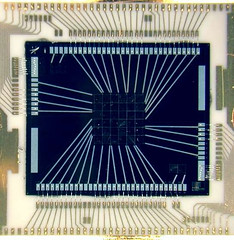
“Calorimeter” is a big word, but the concept behind it is fairly simple. The basic idea is that if you add energy to a system, you can measure the energy by the temperature change of the system.
Here's an example: Take a pot of cool tap water and measure it's temperature. Then, put it on the stove on a hot burner and wait for it to boil. When it boils, take the temperature again. From the temperature difference, and the mass and density of the water and the pot, you could determine how much energy was put into the water and pot by the burner.
X-ray calorimeters are a bit more sophisticated, of course, and are measuring very tiny temperature differences. If a typical X-ray photon with an energy of 6 keV (or a wavelength of 2 Ångstroms) were to be absorbed by a typical US penny, its temperature would only change by 3 parts in 1018 (that's 3 parts in a billion-billion)!
To overcome this problem, the X-ray calorimeters use materials with a much smaller heat capacity than copper, meaning that a smaller energy input causes the temperature to increase more than in copper. In addition, the calorimeters run at very low temperatures (under 1 Kelvin), which also makes the temperature increase more apparent.
There are three main parts to the calorimeter pixel: an absorber, a “thermometer”, and a heatsink. An X-ray entering the detector may be absorbed by the absorber, causing the absorber's temperature to rise. The “thermometer” then reads the temperature change in the absorber due to the X-ray. The thermometers take a couple different forms: they can be transition-edge sensors (or TESs), which use a superconducting material to read the temperature increase, or they can be temperature-senstive transistors, called a thermistors. The whole system is linked weakly to the heatsink, which allows the thermometer and absorber to return to their original temperatures to be ready to detect another X-ray.
Charged Coupled Devices (CCD detectors)
-
Compton Telescopes